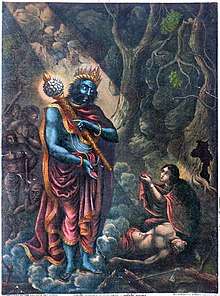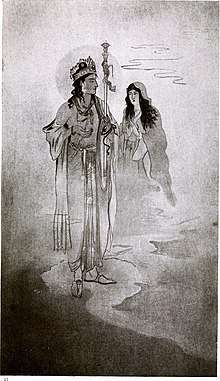Savitri and Satyavan
The oldest known version of the story of Savitri and Satyavan (Sanskrit: सावित्री Sāvitrī and सत्यवान् Satyavān) is found in Vana Parva ("The Book of the Forest") of the Mahabharata...

The story occurs as a multiply-embedded narrative in the Mahabharata as told by sage Markandeya. When Yudhishthira asks Markandeya whether there has ever been a woman whose devotion matched Draupadi’s, Markandeya replies by relating this story.[1]
Story

The childless king of Madra Kingdom, Ashwapati, lives ascetically for many years and offers oblations to Sun God Savitr. His consort is Malavika. Finally, pleased by the prayers, God Savitr appears to him and grants him a boon: he will soon have a daughter.[1] The king is joyful at the prospect of a child. She is born and named Savitri in honor of the god. Savitri is born out of devotion and asceticism, traits she will herself practice.
Savitri is so beautiful and pure, she intimidates all the men in the vicinity. When she reaches the age of marriage, no man asks for her hand, so her father tells her to find a husband on her own. She sets out on a pilgrimage for this purpose and finds Satyavan, the son of a blind king named Dyumatsena of Shalwa Kingdom; Dyumatsena lost everything including his sight, and lives in exile as a forest-dweller with his wife and son.
Savitri returns to find her father speaking with Sage Narada who announces that Savitri has made a bad choice: although perfect in every way, Satyavan is destined to die one year from that day. In response to her father’s pleas to choose a more suitable husband, Savitri insists that she will choose her husband but once. After Narada announces his agreement with Savitri, Ashwapati acquiesces.
Savitri and Satyavan are married, and she goes to live in the forest. Immediately after the marriage, Savitri wears the clothing of a hermit and lives in perfect obedience and respect to her new parents-in-law and husband.
Three days before the foreseen death of Satyavan, Savitri takes a vow of fasting and vigil. Her father-in-law tells her she has taken on too harsh a regimen, but Savitri replies that she has taken an oath to perform these austerities, to which Dyumatsena offers his support.
The morning of Satyavan’s predicted death, Savitri asks for her father-in-law’s permission to accompany her husband into the forest. Since she has never asked for anything during the entire year she has spent at the hermitage, Dyumatsena grants her wish.
They go and while Satyavan is splitting wood, he suddenly becomes weak and lays his head in Savitri’s lap. Servants of Yama the god of Death come and return without the soul of Satyavan due to Savitri's holiness.Then Yama himself comes to claim the soul of Satyavan. Savitri follows Yama as he carries the soul away. When he tries to convince her to turn back, she offers successive formulas of wisdom. First she praises obedience to Dharma, then friendship with the strict, then Yama himself for his just rule, then Yama as King of Dharma, and finally noble conduct with no expectation of return. Impressed at each speech, Yama praises both the content and style of her words and offers any boon, except the life of Satyavan. She first asks for eyesight and restoration of the kingdom for her father-in-law, then a hundred children for her father, and then a hundred children for herself and Satyavan. The last wish creates a dilemma for Yama, as it would indirectly grant the life of Satyavan. However, impressed by Savitri's dedication and purity, he offers one more time for her to choose any boon, but this time omitting "except for the life of Satyavan". Savitri instantly asks for Satyavan to return to life. Yama grants life to Satyavan and blesses both of them to attain life of four hundred years.
Satyavan awakens as though he has been in a deep sleep and returns to his parents along with his wife. Meanwhile, at their home, Dyumatsena regains his eyesight before Savitri and Satyavan return. Since Satyavan still does not know what happened, Savitri relays the story to her parents-in-law, husband, and the gathered ascetics. As they praise her, Dyumatsena’s ministers arrive with news of the death of his usurper. Joyfully, the king and his entourage return to his kingdom.[2][3]
In popular culture

In Bihar, Jharkhand, and Odisha, married women observe Savitri Brata on the Amavasya (new moon) day in the month of Jyestha every year. This is performed for the well-being and long life of their husbands. A treatise entitled Savirti Brata Katha in the Odia language is read out by women while performing the puja. In Western India, the holy day is observed on the Purnima (full moon) of the month as Vat Purnima.
It is believed that Savitri got her husband back on the first day of the Tamil month Panguni. So, this day is celebrated as Karadayan Nonbu in Tamil Nadu. On this day, married women and young girls wear yellow robes and pray to Hindu goddesses for long lives for their husbands. Girls start this practice at a very young age; they wear a yellow robe on this day from the time they are a year old so they will find a good husband in future.
In 1950 and 1951, Sri Aurobindo published his epic poem in blank verse titled "Savitri: A Legend and a Symbol".[4]
In England, Gustav Holst composed a chamber opera in one act in 1916, his Opus 25, named Savitri based on this story.[5]
There have been about thirty-four film versions of the Savitri/Satyavan story produced. One of the earliest is the silent film, Satyavan Savitri (1914) directed by Dadasaheb Phalke. In 1937, Savitri was produced in Hindi directed by Franz Osten.[6] The 1923 version, Savitri also called Satyavan Savitri, was an Italian co-production directed by Giorgio Mannini and J. J. Madan produced by Madan Theatres Ltd and Cines.[7] Savitri (1933) was the first film produced by the East India Film Company. Directed by C. Pullaiah, it received an Honorary Certificate at the Venice Film Festival.[8] In India, many women are named "Savitri". Many films made in South India center on this story. Telugu language film versions of the story have been made since the beginning of talkies, in 1933, 1957, 1977 and 1981. Sati Savitri (1932) was the second talkie Gujarati film.
The Tamil-language films Doctor Savithri (1955) and Roja (1992) are contemporary adaptations of the story of Savitri and Satyvan.[9][10]
The Husband-Wife New Age Group 2002 released an album inspired by the story of Savitri and Satyavan in 1995.[11]
See also
References
- "XVIII: Vana Parva: Wife's Devotion and Satyavana". Vyasa's Mahabharatam. Academic Publishers. 2008. pp. 329–336. ISBN 978-81-89781-68-2.
- Savitri
- Shanta Rameshwar Rao (1 January 1986). In Worship of Shiva. Orient Longman. pp. 29–. ISBN 978-0-86131-684-7.
- Mangesh V. Nadkarni. Savitri – The Golden Bridge, the Wonderful Fire: An introduction to Sri Aurobindo's epic. Auro e-Books. pp. 25–. ISBN 978-93-82474-02-9.
- Head, Raymond, "Holst and India (III)" (September 1988). Tempo (New Ser.), 166: pp. 35–40
- "Savitri Films List". citwf.com. Alan Goble. Retrieved 18 April 2015.
- "Savitri 1923". citwf.com. Alan Goble. Retrieved 18 April 2015.
- Ponram P (1 December 2014). Life in India: Culture. Ponram P. pp. 153–. GGKEY:43NZKK4BRBF. Retrieved 18 April 2015.
- "Doctor Savithri: 1955". The Hindu. Retrieved 18 October 2016.
- Rangan, Baradwaj (2012). Conversations with Mani Ratnam. Penguin Books India. p. 126. ISBN 978-0-670-08520-0.
- http://www.2002music.com/music/cds-dvds/savitri/
Further reading
| Wikiquote has quotations related to: Savitri |
- The Mahabharata vol. 2, tr. J.A.B. van Buitenen (Chicago: University of Chicago Press, 1975)
- The Savitri Brata Katha in Oriya
